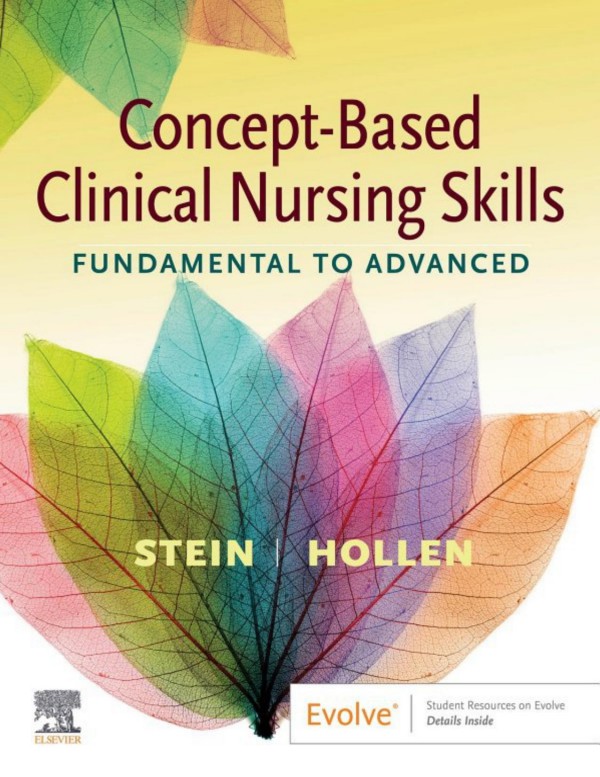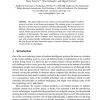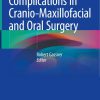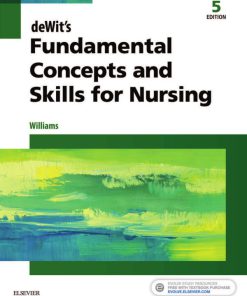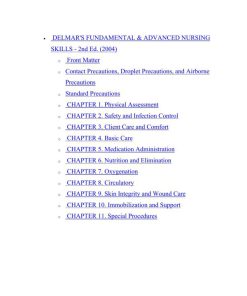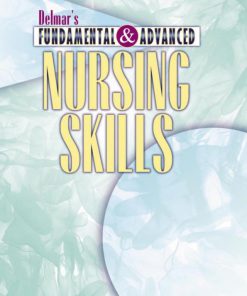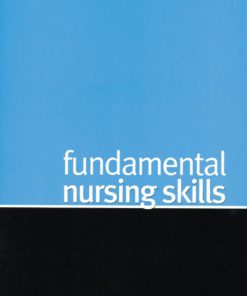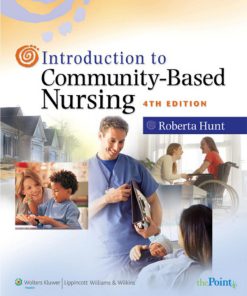Concept Based Clinical Nursing Skills Fundamental to Advanced 1st Edition by Loren Nell Melton Stein MSN RNC NIC, Connie Hollen RN MS ISBN 0323625576 978-0323625579
$50.00 Original price was: $50.00.$25.00Current price is: $25.00.
Authors:Loren Nell Melton Stein; Connie J. Hollen , Series:Nursing [160] , Author sort:Stein, Loren Nell Melton & Hollen, Connie J. , Ids:9780323625586 , Languages:Languages:eng , Published:Published:Feb 2020 , Publisher:Elsevier Inc.
Concept-Based Clinical Nursing Skills: Fundamental to Advanced 1st Edition by Loren Nell Melton Stein MSN RNC-NIC, Connie Hollen RN MS – Ebook PDF Instant Download/Delivery. 0323625576 978-0323625579
Full download Concept-Based Clinical Nursing Skills: Fundamental to Advanced 1st Edition aftern payment
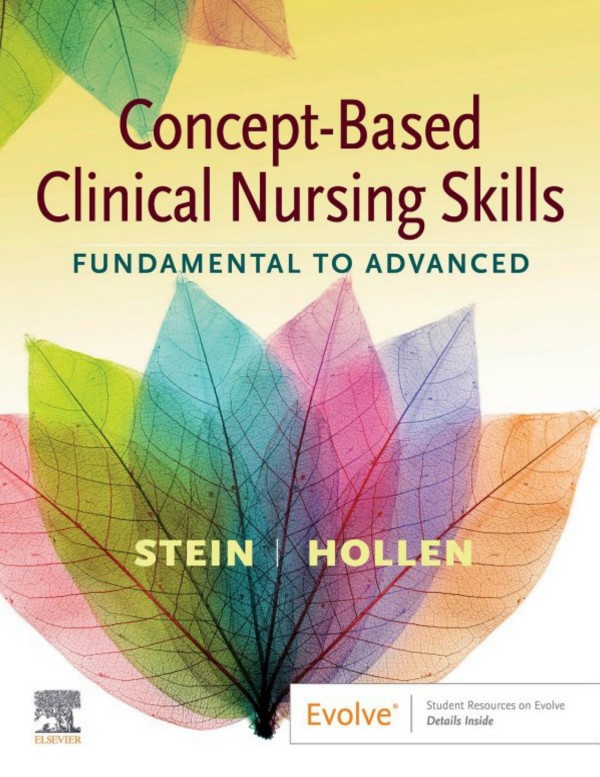
Product details:
ISBN 10: 0323625576
ISBN 13: 978-0323625579
Author: Loren Nell Melton Stein MSN RNC-NIC, Connie Hollen RN MS
Are you looking for a new way of learning skills? Do you want to learn how to problem solve and think conceptually? Stein and Hollen’s Concept-Based Clinical Nursing Skills: Fundamental to Advanced covers over 250 nursing skills in an innovative concept-based format with excellent illustrations, concise rationales, and current evidence. Unlike any other text, Stein and Hollen incorporate an overarching framework of seven critical concepts ― accuracy, client-centered care, infection control, safety, communication, evaluation, and health maintenance ― to drive home the importance of these key themes in performing nursing skills. Each section balances need-to-know narrative with step-by-step skills, and every chapter includes a detailed case study with a concept map to help you apply knowledge and use clinical judgement in clinical situations involving nursing skills.
- Over 250 step-by-step nursing skills with over 900 photos and illustrations.
- Language and concepts reflect those used on the NCLEX.
- Concept-based approach to skills education pairs well with the Giddens framework.
- Accuracy, Client-Centered Care, Infection Control, Safety, Communication, Evaluation, and Health Maintenance are reinforced throughout as Critical Concepts to skills performance.
- Case studies with concept maps depict patients with problems that might be experienced in the clinical setting and are followed by a series of critical thinking questions with every chapter.
- Application of the QSEN competencies: A question that challenges you to apply a QSEN competency is provided within the critical thinking questions of each case study.
- Lessons from the Evidence boxes highlight and summarize current research that can contribute to evidence-based clinical practice; Lessons from the Courtroom boxes summarize actual court cases related to the skills in the chapter in order to help you understand legal implications; and Lessons from Experience boxes use a storytelling format to share the experiences of more experienced nurses with students.
- Application of the nursing process: Nursing diagnoses that include specific examples of client outcomes and nursing interventions are presented within each section of the chapters.
- Uses an easy-to-understand, conversational writing style.
- Organized to present fundamental skills first, then intermediate acute care skills, and finally advanced skills often performed in critical care.
- Critical concepts align with the quality and safety framework of the QSEN competencies.
- Emphasis on safety and client centered care.
- Expect the Unexpected boxes use a storytelling format to present unexpected situations that could occur and explore appropriate responses to them.
- Home Care, Lifespan, and Cultural Considerations provided in each chapter.
- Performing an Assessment chapter details physical assessment skills.
- Evolve site for students features skills video clips, skills checklists for all skills, and NCLEX-style review questions.
Concept-Based Clinical Nursing Skills: Fundamental to Advanced 1st Table of contents:
Unit 1. Fundamental Nursing Skills
Chapter 1. Foundations of Safe Client Care
Section 1 Identifying the Client
Application of the Nursing Process
Section 2 Preventing Infection
Chain of Infection
Preventing the Transmission of Infection
Application of the Nursing Process
Section 3 Moving Clients Safely
Benefits of Proper Client Positioning and Repositioning
Ergonomics and Body Mechanics
Summary
Application of the Nursing Process
Section 4 Using Restraints
Defining Restraints
Use of Securing Devices
Regulations Governing Use of Restraints
Application of the Nursing Process
Chapter 2. Personal Care and Hygiene
Section 1 Bathing a Client
Skin Assessment
Skin Care
Bathing an Adult
Bathing an Infant
Application of the Nursing Process
Section 2 Oral Hygiene
Dentures
Oral Care in the Acute Care Setting
Application of the Nursing Process
Section 3 Providing Hair Care
Shaving
Lice
Application of the Nursing Process
Section 4 Eye and Ear Care
Application of the Nursing Process
Section 5 Assisting With Elimination
Applying Concepts of Safety, Client-Centered Care, Collaboration, and Health Maintenance
Bedside Commode, Urinals, Bedpans, and Condom Catheters
Application of the Nursing Process
Section 6 Making Beds
Application of the Nursing Process
Evaluation (EVAL)
Concept Map
Chapter 3. Vital Signs and Vital Measurements
Vital Signs
Section 1 Assessing Temperature
Sites and Methods of Temperature Assessment
Application of the Nursing Process
Evaluation (EVAL)
Section 2 Regulating Temperature
Regulating Temperature
Application of the Nursing Process
Evaluation (EVAL)
Section 3 Assessing Pulses
Location and Differentiation of Pulses
Apical Pulse
Technique for Assessing Pulses
Alterations of the Client’S Pulse
Application of the Nursing Process
Section 4 Assessing Respirations
Assessing Respirations in Pediatric Clients
Application of the Nursing Process
Section 5 Assessing Blood Pressure
Classification of Hypertension
Factors Affecting Blood Pressure
Measuring Blood Pressure
Application of the Nursing Process
Evaluation (EVAL)
Vital Measurements
Section 6 Assessing Oxygen Saturation
Application of the Nursing Process
Evaluation (EVAL)
Section 7 Assessing Blood Glucose
Application of the Nursing Process
Evaluation (EVAL)
Concept Map
Chapter 4. Performing an Assessment
The Assessment Process
Section 1 Collecting Subjective and Objective Data
Collecting Subjective Data
Collecting Objective Data
Performing a Preliminary Survey
Summary
Section 2 Performing a Head-to-Toe or System-Specific Assessment
Critical Concepts When Performing a Head-to-Toe or System-Specific Assessment
Performing a Rapid Head-to-Toe Bedside Assessment
Performing a System-Specific Assessment
Chapter 5. Nutrition and Gastrointestinal Tube Therapy
Essential and Nonessential Nutrients
Macronutrients and Micronutrients
Digestion and Assimilation of Nutrients
Nutritional Guidelines
Alterations That can Cause Nutritional Deficiencies
Section 1 Nutritional Assessment
Criteria Used for a Nutritional Screening or Assessment
Assessing and Monitoring a Client’s Food and Fluid Intake
Summary
Application of the Nursing Process
Section 2 Assisting Clients With Oral Nutrition
Types of Diets
Preparing A Client to Receive a Meal
Assisting A Client who has Difficulty Eating
Application of the Nursing Process
Section 3 Providing Gastric Tube Therapy
Nasogastric Sump Tube
Levin Tubes and Gastric Lavage Tubes
Placement And Care Of A Nasogastric Sump Tube
Summary
Application of the Nursing Process
Section 4 Providing Enteral Nutrition
Routes of Enteral Feeding
Daily Care for Clients With Gastrostomy, peg, and Jejunostomy Tubes
Delivery Methods for Enteral Nutrition
Reducing Risks of Enteral Nutrition
Home Care Considerations
Providing Client-Centered Care During Enteral Nutrition
Summary
Application of the Nursing Process
Concept Map
Chapter 6. Supporting Mobility and Immobilization
Section 1 Supporting Mobility
Collaborative Care for Clients With Assistive Devices
Range of Motion
Application of the Nursing Process
Section 2 Supporting Immobilization
Supporting Immobilization of a Limb or Joint
Supporting Cervical Immobilization
Pin Care
Application of the Nursing Process
Section 3 Caring for a Client With an Amputation
Communication: Client Education and Collaboration
Application of the Nursing Process
Concept Map
Chapter 7. Comfort Care
The Impact of Pain
Nociceptive and Neuropathic Pain
Acute and Chronic Pain
Section 1 Assessment of Pain and Discomfort
Subjective and Objective Assessment of Pain
Examples of Pain Tools Used for Assessment of Pain
Assessment of Pain for Diverse Populations
Lifespan Considerations: Older Adults and Pediatric Clients
Summary of Best Practice Recommendations for Assessment of Pain
Summary of Application of Critical Concepts for Assessment of Pain
Application Of The Nursing Process
Section 2 Using Relaxation Measures to Promote Comfort
Enhancing the Client’s Environment
Controlled Breathing
Guided Imagery
Massage Therapy
Summary
Application Of The Nursing Process
Section 3 Using a TENS Unit to Promote Comfort
Application of the Nursing Process
Section 4 Using Heat or Cold to Promote Comfort
Safety Considerations and Precautions for Heat and Cold Therapy
Different Types of Heat and Cold Therapy
Summary
Application of the Nursing Process
Section 5 Using Patient-Controlled Analgesia to Promote Comfort
Safety Considerations When Using PCA Therapy
Summary
Application Of The Nursing Process
Section 6 Using Epidural Analgesia to Promote Comfort
Safety Considerations for Epidural Catheters
Potential Complications of Epidural Catheters
Summary
Chapter 8. End-of-Life Care
Definition of End of Life
End-of-Life Care and Palliative Care
Nursing Initiatives and End-of-Life Care
Section 1 Bereavement and Spiritual Care
Theories of Grieving
Types of Grief
Children and Grief
Nurses and Grief
Providing Spiritual Care for a Client and Family
Summary
Section 2 Assisting a Client and Family With Advance Care Planning
Tools Used for Advance Care Planning
Application of the Nursing Process
Section 3 Caring for a Client Near the End of Life
Application of the Nursing Process
Section 4 Caring for a Client After Death
Application of the Nursing Process
Concept Map
Unit 2. Intermediate Nursing Skills
Chapter 9. Airway and Breathing
Section 1 Maintaining the Health of the Respiratory System
Deep Breathing and Coughing
Incentive Spirometry
Chest Physiotherapy
Respiratory System-Specific Assessment
Application of the Nursing Process
Section 2 Administering Oxygen
Impaired Gas Exchange
Using a High-Pressure Oxygen Cylinder
Administering Supplemental Oxygen
Summary
Application of the Nursing Process
Section 3 Establishing and Maintaining an Open Airway
Oropharyngeal Airway
Nasopharyngeal Airway
Nasopharyngeal Suctioning
Tracheostomy
Suctioning an Artificial Airway
Collecting Sputum Samples
Summary
Application of the Nursing Process
Concept Map
Chapter 10. Sterile Technique
Section 1 Preparing a Sterile Field
Application of the Nursing Process
Section 2 Preparing to Enter a Sterile Perioperative Setting
Surgical Attire
Surgical Hand Antisepsis
Surgical Gowns and Gloves
Application of the Nursing Process
Concept Map
Chapter 11. Medication Administration
Medication Safety Initiatives
Rights of Medication Administration
Safely Processing Medication Orders
Performing Preassessments
Safely Preparing and Distributing Medications
Performing Safety Checks
Safety Considerations for High-Alert Medications
Performing Dosage Calculation
Section 1 Administering Oral Medications
Types of Oral Medications
Crushing/Altering Oral Medications
Preparing and Administering Oral Medications
Best-Practice Recommendations
Pediatric Considerations
Home Care and Geriatric Considerations
Summary
Application of the Nursing Process
Section 2 Administering Enteral Medications
Application of the Nursing Process
Section 3 Administering Mucous Membrane Applications
Sublingual and Buccal Medications
Nasal Instillations
Inhalers and Nebulizers
Rectal and Vaginal Administration
Application of the Nursing Process
Section 4 Administering Topical Medications
Topical Medications for Localized Effect
Transdermal Medications for Systemic Effect
Eye and Ear Medications
Application of the Nursing Process
Section 5 Administering Parenteral Medications
Preparing Equipment for Injections
Components of a Needle and Syringe
Using Safety and Needleless Systems
Preparing Medications
Administering Injections
Administering Intradermal Injections
Administering Subcutaneous Injections
Administering Intramuscular Injections
Administering Insulin
Summary
Application of the Nursing Process
Concept Map
Chapter 12. Venous Access
Section 1 Collecting Venous Blood Specimens
Ensuring Accuracy
Selecting a Vein
Application of the Nursing Process
Section 2 Initiating, Dressing, and Discontinuing a Peripheral Intravenous Catheter
Selecting a Vein
Application of the Nursing Process
Section 3 Intravenous Fluids
Monitoring Intake and Output
Types of Intravenous Fluids
Infection Control
Safety and the Rights of Intravenous Fluid Administration
Intravenous Fluid Administration Sets
Priming Administration Sets and Bubble Management
Infusing Fluids
Application of the Nursing Process
Section 4 Administering Intravenous Medications
Orders for Intravenous Medications
Nursing Responsibilities
Medication Preparation and Equipment
Complications of Intravenous Medication Administration
Application of the Nursing Process
Section 5 Administering a Blood Transfusion
Different Types of Blood Components
Types of Blood Transfusions
ABO Compatibility System
Safety Considerations
Equipment Used for a Blood Transfusion
Procedure for Administering a Blood Transfusion
Possible Complications
Application of the Nursing Process
Concept Map
Chapter 13. Central Venous Access
Caring for a Client With a CVAD
Tunneled Catheters
Nontunneled Catheters
Implanted Ports
Power-Injection Capable
Assisting with Insertion
Complications of CVADs
Drawing Blood From a CVAD
Care for a Client With a Subcutaneous Port: Accessing and Deaccessing
Discontinuing a CVAD
Critical Concepts and CVADs
Application of the Nursing Process
Section 2 Infusing Fluids With a CVAD
Application of the Nursing Process
Concept Map
Chapter 14. Bowel Management
Characteristics of Stool
Section 1 Supporting Healthy Bowel Elimination
Bowel Elimination Problems
Application of the Nursing Process
Section 2 Administering Enemas
Application of the Nursing Process
Section 3 Collecting Specimens
Application of the Nursing Process
Section 4 Caring for a Client With a Bowel Diversion
Care of the Stoma and Peristomal Skin
Irrigating a Colostomy
Cecostomy
Application of the Nursing Process
Concept Map
Chapter 15. Urine Elimination
Urine Elimination
Section 1 Collecting Urine Measurements and Specimens
Assessing Production and Volume of Urine
Collecting Specimens
Application of the Nursing Process
Section 2 Urine Elimination With a Transurethral Catheter
Types of Transurethral Catheters
Infection Control With Urinary Catheters
Communication and Urinary Catheters
Providing Client-Centered Care to Specific Populations
Bladder Irrigation
Application of the Nursing Process
Section 3 Urine Elimination With a Urinary Diversion
Suprapubic Catheter
Urinary Diversions
Application of the Nursing Process
Concept Map
Chapter 16. Wound Care
Section 1 Providing Wound Care
Wound Types
The Impact of Wounds
Client Considerations
Wound Assessment
Wound Care
Collecting Wound Specimens
Managing Complex Wounds
Dressing Selection and Application
Application of the Nursing Process
Section 2 Managing Wound Drainage
Application of the Nursing Process
Section 3 Preventing and Treating Pressure Injury and Venous and Diabetic Ulcers
Pressure Injury
Venous Ulcers
Preventing Diabetic Ulcers
Application of the Nursing Process
Concept Map
Chapter 17. Perioperative Care
Section 1 Providing Preoperative Education and Care
Factors Affecting Surgical Risks
Nursing History and Physical Examination
Cultural Considerations
Informed Consent
Preoperative Teaching
Application of the Nursing Process
Section 2 Providing Intraoperative Care
Surgical Verification
Client Positioning
Maintaining Safety: Latex Sensitivity/Allergy
Types of Anesthesia
Preparing the Client’s Skin
Closing the Wound
Application of the Nursing Process
Section 3 Managing Postoperative Care
Postoperative Assessment
Postoperative Teaching
Application of the Nursing Process
Concept Map
Unit 3. Advanced Nursing Skills
Chapter 18. Advanced Respiratory Management
Section 1 Caring for a Client With Invasive Mechanical Ventilation
The Airway: Endotracheal Tubes
Providing Mechanical Ventilation
Nursing Care for Clients Who Are Receiving Mechanical Ventilation
Reducing the Risk of Complications of Mechanical Ventilation
Application of the Nursing Process
Arterial Blood Gases
Acid–Base Imbalances
Section 2 Caring for a Client Who Requires Arterial Blood Gas Sampling
Indwelling Arterial Catheter Sampling
Arterial Puncture Sampling
Application of the Nursing Process
Section 3 Caring for a Client With a Chest Tube
Chest Drainage Systems
Caring for the Client With a Chest Tube and Chest Drainage System
Troubleshooting the Chest Tube and Drainage System
Application of the Nursing Process
Concept Map
Chapter 19. Advanced Cardiovascular Care
Cardiovascular System
Section 1 Caring for a Client on Cardiac Monitoring
Cardiac Conduction System
The ECG Tracing
Equipment Used in ECG Monitoring
Lead Placement for ECG Monitoring
Types of ECG Monitoring
Performing a 12-Lead ECG
Possible Safety and Technical Issues with ECG Monitoring
Summary
Application of the Nursing Process
Section 2 Caring for a Client With a Dysrhythmia or Altered Cardiac Conduction
Dysrhythmias and Conduction Disorders
Using Synchronized Cardioversion
Summary
Application of the Nursing Process
Section 3 Caring for a Client With a Cardiac Pacemaker
How a Pacemaker Works: Major Functions and Components
Types of Pacemakers
Temporary Pacemakers
Permanent Pacemakers
Possible Complications/Safety Issues With Pacemakers
Application of the Nursing Process
Section 4 Caring for a Client With a Cardiac Emergency
Caring for a Client With Ischemic Chest Pain
Emergency Cardiac Catheterization
Providing Emergency Defibrillation
Caring for a Client Who Is in Cardiac Arrest
Application of the Nursing Process
Concept Map
Chapter 20. Advanced Neurologic Care
Intracranial Processes
Major Neurologic Injuries: Traumatic and Nontraumatic
Section 1 Advanced Neurologic Assessment
Assessment of Level of Consciousness
Assessment of Pupillary Response and Function
Using a Pupillometer Device for Assessment of Pupils
Assessment of Verbal Response and Function
Assessment of Motor and Sensory Function
Assessment of Deep Tendon Reflexes
Lifespan Considerations
Diagnostic Procedures
Summary
Application of the Nursing Process
Section 2 Caring for a Client With Increased Intracranial Pressure (ICP)
Interventions for Clients With Increased ICP
Caring for a Client With an External Ventricular Drain and Performing ICP Monitoring
Summary
Application of the Nursing Process
Section 3 Caring for a Client With a Neurologic Emergency
Caring for a Client Who Is Having a Seizure
Caring for a Client Who May Be Having an Acute Stroke
Summary
Application of the Nursing Process
Concept Map
Illustration Credits
People also search for Concept-Based Clinical Nursing Skills: Fundamental to Advanced 1st:
concept based clinical nursing skills
clinical nursing skills a concept based approach
clinical nursing skills a concept based approach 4th edition
clinical nursing skills a concept based approach to.learning
what are clinical skills in nursing
You may also like…
eBook PDF
Fundamental Nursing Skills 1st Edition by Penelope Ann Hilton ISBN 0470032391 9780470032398
eBook PDF
Introduction to Community Based Nursing 4th Edition by Roberta Hunt RN 0781772478 9780781772471

